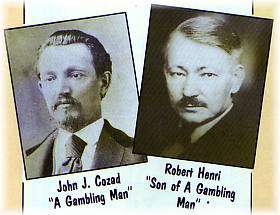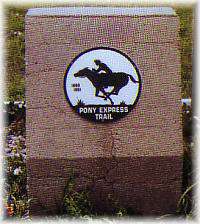John J. Cozad - Biography
category : Famous People
 It was a beautiful summer Sunday in 1872, clear and fresh, the only movement on the endless prairie being the wind sweeping over the long grass. The Union Pacific westbound train has passed a short time ago, and John Cusack, the Union Pacific Section Boss at Darr, Nebraska, had watched it disappear down the tracks. It was another long prairie day for Cusack, and little did he know that it was to be one of the most memorable days of his life. He had to check some track so he got on the hand car and headed west. Soon he saw a speck on the horizon, a black speck coming toward him down the track. He hurried on to investigate, and he remembered always the strange sight as he approached. It was a man, nattily dresses in a dark swallow-tail suit, the coat tails "flying in the wind," a high silk hat, gold-headed cane, and even a large diamond stick pin in his black cravat.
It was a beautiful summer Sunday in 1872, clear and fresh, the only movement on the endless prairie being the wind sweeping over the long grass. The Union Pacific westbound train has passed a short time ago, and John Cusack, the Union Pacific Section Boss at Darr, Nebraska, had watched it disappear down the tracks. It was another long prairie day for Cusack, and little did he know that it was to be one of the most memorable days of his life. He had to check some track so he got on the hand car and headed west. Soon he saw a speck on the horizon, a black speck coming toward him down the track. He hurried on to investigate, and he remembered always the strange sight as he approached. It was a man, nattily dresses in a dark swallow-tail suit, the coat tails "flying in the wind," a high silk hat, gold-headed cane, and even a large diamond stick pin in his black cravat.The man was tall, dark, and stately, with beady black eyes that seemed to pierce through a person. The man stopped at the 100th Meridian sign and was looking north. That very spot was a beautiful one because it was in the middle of the fourteen mile valley between the north and south hills, a lovely valley. Mr. Cusack stopped to talk to the man whose name was John J. Cozad from Cincinnati, Ohio. Mr. Cozad had been on the train, had seen the 100th Meridian sign, and had gotten off the train at the next stop, Willow Island and had walked back east down the tracks to the sign. The men talked at length, and Mr. Cozad told Mr. Cusack about his desire to establish a new town right here at the 100th Meridian. He could foresee the future buildings that would stand there: grain elevators, stores, livery stables, cattle yards, churches and schools and fields of grain. He would build a "Meridian Avenue" right from the sign north, a wide tree-lined street and at the end of the avenue he would build a beautiful home for his wife Theresa and his sons Johnny and Robert. His town would be a clean town; there would be no drinking, no gambling, no carousing; it would be a peaceful town, full of energetic, hard-working people, whom he would bring out from Ohio and the eastern states. Convinced that his decision on this location was a wise choice, he got on the hand car with Mr. Cusack and returned to Willow Island where John J. Cozad waited for the train back to Ohio.
John J. Cozad did return to Ohio, bought 40 thousand acres of land from the Union Pacific Railroad and began to organize a campaign to urge Ohioans to move west to a new and wonderful country where the soil was fertile, the air pure and the opportunities endless. Mr. Cozad (a title used always in reference to him as no one ever called him John) was a handsome, colorful, vigorous man, always meticulously dressed. He was a man of a few well-chosen words; he was aloof and cold. He had established a town called Cozaddale, near Cincinnati, and his business was land speculation although his avocation was gambling, especially for the game of Faro. His mother died when he was young; he and his stepmother were not compatible so he left home at the age of twelve. After trying a number of ways to make a living, he decided to make his fortune gambling. He seemed to have a natural ability because of his keen mind and piercing eyes. Some said that he could see right through the cards; however, he watched his opponents carefully until he could detect some mannerism or eye movement that indicated what was in his opponent's hand. It was this astute psychological study of people that made him a winner. He was so good that eventually he was barred from any river boats, railroad and large gambling halls. Theresa once said that between trains in Omaha, he made $50,000.00 in the gambling room. Throughout his life, whenever he needed money, he left town and sought out a Faro game somewhere.
John J. Cozad had a violent temper, a haughty pride and very little tact, so he was constantly making enemies. One day when he returned to town from a business trip, he was faced by a man named Alfred Pearson. They argued. Pearson pushed Cozad down and in getting up, Cozad thought he saw Pearson go for a knife. Mr. Cozad shot him, injuring the man. Mr. Pearson died two months later. Because of the high feeling against Mr. Cozad, he decided to leave town immediately. Feelings ran high against the Cozad's, and as soon as Theresa could get the business in shape and sell the property and other assets, she sewed the money in her skirts and in Robert's coat pockets and left Cozad forever. (Johnny had already gone to Denver to care for the liquidation of the hay business there.) The Cozad family disappeared and the town of Cozad did not know what happened to the founder. In 1956 the true story came out from a family member of Mrs. Cozad's who had recently traced the family history. Theresa and John J. became Mr. and Mrs. Richard Lee and went to Atlantic City, New Jersey, bought land on the famous Boardwalk and established a gambling house known as Lee's Fort. Johnny became Dr. John Southern, a well-known doctor, and Robert became Robert Henri (pronounced Hen-rye), the famous artist and teacher of art in New York.
Come visit us in Cozad, Nebraska
